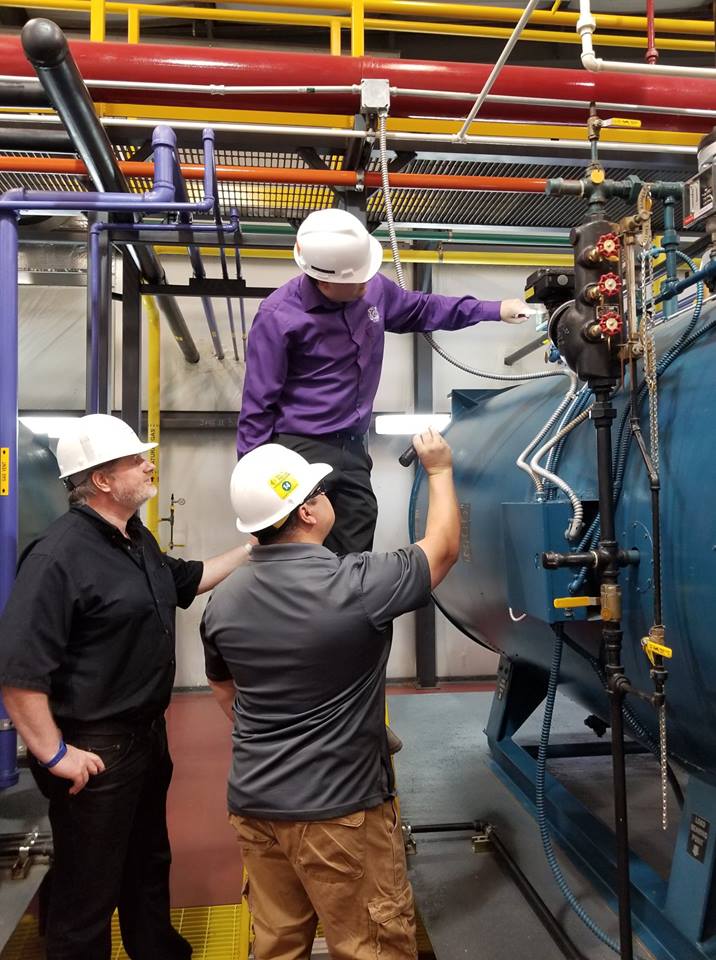GCAP steam machines receive inspections under the Kansas Fire Marshal. A small part of GCAP’s boiler level 2 class is educating students on how to prepare boilers for both external (while in operation) and internal inspections. We have incorporated a live inspection from the state as well to help enhance this understanding. The national board suggests the following to be part of these inspections as well. If you would like more information on GCAP’s hands-on boiler courses please visit this link.
External – while in operation
Upon entering the boiler room, the inspector should perform a general assessment of the boiler, piping, controls, fuel system, and combustion air supply.
The inspector should then:
- Review the current operating certificate (if one was issued in the past) and compare the information to the associated boiler and its stamping or nameplate.
- Compare the safety or safety relief valve(s) nameplate data (set pressure and relieving capacity) with the boiler stamping or nameplate to ensure the safety or safety relief valve(s) is(are) adequate for this installation.
- Inspect the safety or safety relief valve operation as described in the National Board Inspector Guide for Pressure Relief Devices.
- Inspect the low-water fuel cutoff and water feeding device (if applicable) as described in the National Board Inspector Guide for Water Level Controls and Devices.
- Inspect the feedwater supply system (if applicable) to ensure it meets Code and jurisdictional requirements.
- Inspect the pressure or temperature controls as described in the National Board Inspector Guide for Operating Controls.
- Check the pressure or altitude gage reading (if there is a reason to question the accuracy of the gage, it should be replaced or recalibrated).
- Check the temperature gage reading on Section I high-temperature water boilers, or the thermometer reading on Section IV hot water boilers. (If there is a reason to question the accuracy of either, they should be replaced or recalibrated.)
- Check the water gage glass to ensure it provides a clear indication of the water level in a steam boiler. (Please see the National Board Inspector Guide for Water Level Controls and Devices.)
- If a steam boiler has a MAWP over 400 psi, ensure that any remote water level indicators are functioning and indicate the same water level as the gage glass (PG-60.1.1).
- Look closely for leaks at all pipe connections associated with the boiler.
- Look closely for leaks originating from under the boiler casing and insulation and instruct the owner or owner’s representative to remove the casing and insulation as necessary to pinpoint any leaks.
- Look for evidence of overheating.
- Witness any pressure test required by the jurisdiction.
- Inspect the fuel-burning apparatus as required by the jurisdiction.
Internal
Internal inspections of firetube boilers can range from looking into inspection openings with a mirror and flashlight to actually crawling inside when the boiler and access openings are large enough. Any time the inspector’s head enters the fireside or waterside of the boiler, the atmosphere must first be checked for oxygen content and the presence of flammable, explosive, or hazardous gases. The inspector must comply with all applicable confined space entry rules and procedures.
The inspector should:
- Look in all inspection openings to check for scale, sludge, and sediment and, instruct the owner or owner’s representative to remove any build-up which prevents a thorough inspection.
- Look for corrosion, overheating, bulges or blisters, and cracks.
- Look at the steam/water line area for evidence of corrosion and oxygen pitting on steam boilers.
- Investigate any appearance of water in the fireside spaces.
- Check all stays with telltale holes for evidence of leakage through the hole which would indicate a broken stay.
- All stays should be examined to determine if they are sound and able to support the stayed area.
- Check for cracks in the tube ends and tube sheet ligaments.
- Look through the tubes to check for obstructions and sagging of the tubes.
- Ensure that refractory and/or fire brick is properly placed and secure.
- Look for flame impingement on any surfaces exposed to the direct flame.
- Ensure any supporting structure or foundation for the boiler is in good condition.
- Examine the interior and operating mechanism of float-type low-water fuel cutoffs and water-feeding devices.
- Ensure that all piping and connections for low-water cutoffs, water columns, and gage glasses are free of obstructions.



